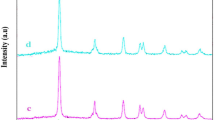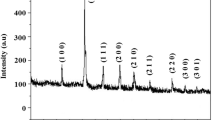Abstract
The aim of this work is to study the catalytic activity of titanate nanorods materials doped by platinum and gold nanoparticles in the photodegradation reaction of methyl orange. Nanorods are metalized by deposition precipitation with urea and impregnation at 2 wt% of metal. The characteristics of materials are determined using the following methods: photoelectron spectroscopy, transmission electron microscopy, UV–Vis in reflection diffuse (RDS/UV–Vis), X-ray diffraction, N2 adsorption–desorption and ICP analysis. The results of characterization proved the formation of nanorods structure using hydrothermal method and an almost total homogeneous deposition of the metallic nanoparticles on the nanorod surface. All materials are used in the photodegradation of organic pollutant dye (methyl orange) under UV or visible irradiations. Pt doped nanorods shows the best catalytic activity in the photodegradation of dye. The conversion and mineralization rates achieved 100 and 78%, respectively.





Similar content being viewed by others
Data availability
Not applicable.
References
Lachheb H, Puzenat E, Houas A, Ksibi M, Elaloui E, Guillard C, Herrmann J-M (2002) Photocatalytic degradation of various types of dyes (Alizarin S, Crocein Orange G, Methyl Red, Congo Red, Methylene Blue) in water by UV-irradiated titania. Appl Catal B 39:75–90
Serpone N (2018) Heterogeneous photocatalysis and prospects of TiO2-based photocatalytic DeNOxing the atmospheric environment. Catalysts 8:553
Saadati M, Akhavan O, Fazli H (2021) Single-layer MoS2–MoO3–x heterojunction nanosheets with simultaneous photoluminescence and co-photocatalytic features. Catalysts 11:1445
Stylidi M, Kondarides DI, Verykios XE (2003) Pathways of solar light-induced photocatalytic degradation of azo dyes in aqueous TiO2 suspensions. Appl Catal B 40:271–286
Chong MN, Jin B, Chow CW, Saint C (2010) Recent developments in photocatalytic water treatment technology: a review. Water Res 44:2997–3027
Cai C, Zhang Z, Liu J, Shan N, Zhang H, Dionysiou DD (2016) Visible light-assisted heterogeneous Fenton with ZnFe2O4 for the degradation of Orange II in water. Appl Catal B 182:456–468
Akpan UG, Hameed BH (2009) Parameters affecting the photocatalytic degradation of dyes using TiO2-based photocatalysts: a review. J Hazard Mater 170:520–529
Qin L-Z, Liao B, Dong X-L, Wu X-Y, Hou X-G, Liu A-D (2009) Ag/Fe:TiO2 nano-catalysts prepared by Fe ion implantation and Ag nanoparticle deposition by electron beam irradiation. Nucl Instrum Methods Phys Res Sect B 267:1077–1080
Fernandes A, Makoś P, Wang Z, Boczkaj G (2020) Synergistic effect of TiO2 photocatalytic advanced oxidation processes in the treatment of refinery effluents. Chem Eng J 391:123488
Ebrahimi M, Akhavan O (2022) Nanomaterials for photocatalytic degradations of analgesic, mucolytic and anti-biotic/viral/inflammatory drugs widely used in controlling SARS-CoV-2. Catalysts 12:667
Poyatos JM, Muñio M, Almecija M, Torres J, Hontoria E, Osorio F (2010) Advanced oxidation processes for wastewater treatment: state of the art. Water Air Soil Pollut 205:187–204
Hernández R, Durón-Torres SM, Esquivel K, Guzmán C (2017) Microwave assisted sol–gel synthesis and characterization of M–TiO2 (M= Pt, Au) photocatalysts. Characterization of metals and alloys. Springer International Publishing, Cham, pp 183–189
Macwan D, Dave PN, Chaturvedi S (2011) A review on nano-TiO2 sol–gel type syntheses and its applications. J Mater Sci 46:3669–3686
Chen X, Mao SS (2007) Titanium dioxide nanomaterials: synthesis, properties, modifications, and applications. Chem Rev 107:2891–2959
Liŭ D, Li Z, Wang W, Wang G, Liú D (2016) Hematite doped magnetic TiO2 nanocomposites with improved photocatalytic activity. J Alloys Compd 654:491–497
Lei X, Xue X, Yang H (2014) Preparation and characterization of Ag-doped TiO2 nanomaterials and their photocatalytic reduction of Cr (VI) under visible light. Appl Surf Sci 321:396–403
Liu L, Gao F, Zhao H, Li Y (2013) Tailoring Cu valence and oxygen vacancy in Cu/TiO2 catalysts for enhanced CO2 photoreduction efficiency. Appl Catal B 134:349–358
Akhavan O (2009) Lasting antibacterial activities of Ag–TiO2/Ag/a–TiO2 nanocomposite thin film photocatalysts under solar light irradiation. J Colloid Interface Sci 336:117–124
Rosseler O, Shankar MV, Du Karkmaz-Le M, Schmidlin L, Keller N, Keller V (2010) Solar light photocatalytic hydrogen production from water over Pt and Au/TiO2 (anatase/rutile) photocatalysts: influence of noble metal and porogen promotion. J Catal 269:179–190
Maicu M, Hidalgo M, Colón G, Navío JA (2011) Comparative study of the photodeposition of Pt, Au and Pd on pre-sulphated TiO2 for the photocatalytic decomposition of phenol. J Photochem Photobiol A 217:275–283
Zou X, Dong Y, Zhang X, Cui Y (2016) Synthesize and characterize of Ag3VO4/TiO2 nanorods photocatalysts and its photocatalytic activity under visible light irradiation. Appl Surf Sci 366:173–180
Liu J, Li Y, Ke J, Wang S, Wang L, Xiao H (2018) Black NiO–TiO2 nanorods for solar photocatalysis: Recognition of electronic structure and reaction mechanism. Appl Catal B 224:705–714
Meng X-D, Wang D-Z, Liu J-H, Zhang S-Y (2004) Preparation and characterization of sodium titanate nanowires from brookite nanocrystallites. Mater Res Bull 39:2163–2170
Watanabe M, Uchida M, Motoo S (1987) Preparation of highly dispersed Pt + Ru alloy clusters and the activity for the electrooxidation of methanol. J Electroanal Chem Interfacial Electrochem 229:395–406
Arico A, Shukla A, Kim H, Park S, Min M, Antonucci V (2001) An XPS study on oxidation states of Pt and its alloys with Co and Cr and its relevance to electroreduction of oxygen. Appl Surf Sci 172:33–40
Parkinson C, Walker M, McConville C (2003) Reaction of atomic oxygen with a Pt (111) surface: chemical and structural determination using XPS, CAICISS and LEED. Surf Sci 545:19–33
Kim M-J, Na H-J, Lee KC, Yoo EA, Lee M (2003) Preparation and characterization of Au–Ag and Au–Cu alloy nanoparticles in chloroform. J Mater Chem 13:1789–1792
Si R, Flytzani-Stephanopoulos M (2008) Shape and crystal-plane effects of nanoscale ceria on the activity of Au–CeO2 catalysts for the water–gas shift reaction. Angew Chem 120:2926–2929
Gluhoi AC, Bogdanchikova N, Nieuwenhuys BE (2005) Alkali (earth)-doped Au/Al2O3 catalysts for the total oxidation of propene. J Catal 232:96–101
Sangpour P, Akhavan O, Moshfegh A, Roozbehi M (2007) Formation of gold nanoparticles in heat-treated reactive co-sputtered Au–SiO2 thin films. Appl Surf Sci 254:286–290
Ameur N, Bedrane S, Bachir R, Choukchou-Braham A (2013) Influence of nanoparticles oxidation state in gold based catalysts on the product selectivity in liquid phase oxidation of cyclohexene. J Mol Catal A: Chem 374–375:1–6
Ameur N, Berrichi A, Bedrane S, Bachir R (2014) Preparation and characterization of Au/Al2O3 and Au–Fe/Al2O3 materials, active and selective catalysts in oxidation of cyclohexene. Adv Mater Res 856:48–52
Simakov A, Tuzovskaya I, Bogdanchikova N, Pestryakov A, Avalos M, Farias M, Smolentseva E (2008) Influence of sodium on activation of gold species in Y–zeolites. Catal Commun 9:1277–1281
Eustis S, El-Sayed MA (2006) Why gold nanoparticles are more precious than pretty gold: noble metal surface plasmon resonance and its enhancement of the radiative and nonradiative properties of nanocrystals of different shapes. Chem Soc Rev 35:209–217
Karooby E, Granpayeh N (2019) Potential applications of nanoshell bow-tie antennas for biological imaging and hyperthermia therapy. Opt Eng 58:065102–065102
Pestryakov A, Tuzovskaya I, Smolentseva E, Bogdanchikova N, Jentoft FC, Knop-Gericke A (2005) Formation of gold nanoparticles in zeolites. Int J Mod Phys B 19:2321–2326
Jiang H, Meng X, Dai H, Deng J, Liu Y, Zhang L, Zhao Z, Zhang R (2012) High-performance porous spherical or octapod-like single-crystalline BiVO4 photocatalysts for the removal of phenol and methylene blue under visible-light illumination. J Hazard Mater 217:92–99
Ameur N, Bachir R (2020) Study of 1D titanate-based materials-new modification of the synthesis procedure and surface properties-recent applications. ChemistrySelect 5:1164–1185
Anpo M, Takeuchi M (2003) The design and development of highly reactive titanium oxide photocatalysts operating under visible light irradiation. J Catal 216:505–516
Irmak S, Kusvuran E, Erbatur O (2004) Degradation of 4-chloro-2-methylphenol in aqueous solution by UV irradiation in the presence of titanium dioxide. Appl Catal B 54:85–91
Konstantinou IK, Albanis TA (2004) TiO2-assisted photocatalytic degradation of azo dyes in aqueous solution: kinetic and mechanistic investigations: a review. Appl Catal B 49:1–14
Wang Y, Hong C-S (1999) Effect of hydrogen peroxide, periodate and persulfate on photocatalysis of 2-chlorobiphenyl in aqueous TiO2 suspensions. Water Res 33:2031–2036
Navío JA, Colón G, Sánchez-Soto PJ, Macias M (1997) Effects of H2O2 and SO42-species on the crystalline structure and surface properties of ZrO2 processed by alkaline precipitation. Chem Mater 9:1256–1261
Hirakawa T, Nosaka Y (2002) Properties of O2∙− and OH∙ formed in TiO2 aqueous suspensions by photocatalytic reaction and the influence of H2O2 and some ions. Langmuir 18:3247–3254
Sahel K, Elsellami L, Mirali I, Dappozze F, Bouhent M, Guillard C (2016) Hydrogen peroxide and photocatalysis. Appl Catal B 188:106–112
Boonstra A, Mutsaers C (1975) Adsorption of hydrogen peroxide on the surface of titanium dioxide. J Phys Chem 79:1940–1943
Ohno T, Masaki Y, Hirayama S, Matsumura M (2001) TiO2-photocatalyzed epoxidation of 1-decene by H2O2 under visible light. J Catal 204:163–168
Li X, Chen C, Zhao J (2001) Mechanism of photodecomposition of H2O2 on TiO2 surfaces under visible light irradiation. Langmuir 17:4118–4122
Pavel CC, Park S-H, Dreier A, Tesche B, Schmidt W (2006) Structural defects induced in ETS-10 by postsynthesis treatment with H2O2 solution. Chem Mater 18:3813–3820
Acknowledgements
The authors extend their appreciation to the Deanship of Scientific Research at King Khalid University for funding this work through large group Research project under Grant Number RGP2/47/44.
Funding
Not applicable.
Author information
Authors and Affiliations
Contributions
All authors contributed to the study conception and redaction. Material preparation, data collection and analysis are performed by all authors. The first draft of the manuscript is written and commented by Sanaa Ben Moussa.
Corresponding author
Ethics declarations
Competing interests
The authors declare no competing interests.
Ethical approval
Not applicable.
Additional information
Publisher's Note
Springer Nature remains neutral with regard to jurisdictional claims in published maps and institutional affiliations.
Supplementary Information
Below is the link to the electronic supplementary material.
Rights and permissions
Springer Nature or its licensor (e.g. a society or other partner) holds exclusive rights to this article under a publishing agreement with the author(s) or other rightsholder(s); author self-archiving of the accepted manuscript version of this article is solely governed by the terms of such publishing agreement and applicable law.
About this article
Cite this article
Ben Moussa, S. Application of the metallized titanate nanorod in the photodegradation of methyl orange. Reac Kinet Mech Cat 136, 2397–2408 (2023). https://doi.org/10.1007/s11144-023-02460-6
Received:
Accepted:
Published:
Issue Date:
DOI: https://doi.org/10.1007/s11144-023-02460-6




